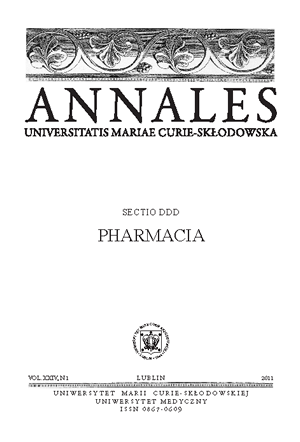Some biochemical parameters of kidney functionin rats after acute poisoning with tin chloride
Keywords:
acute tin chloride intoxication, rats, biochemical parameters, damage of kidney functionAbstract
Kidney is the main target organ for many heavy metals. The toxic effect of tin on kidneys is still not clear. The aim of this study was to assess the function of kidneys in rats acutely intoxicated by tin chloride. The study was carried out on male Wistar rats. Animals were given intraperitioneally (ip) tin chloride in a dose of 63.2 mg/kg b.w. After 48 h or 11-days from acute intoxication, the rats were decapitated and blood was collected. Ready-made diagnostic kits were used for biochemical measurements: urea, creatinine and beta-2 microglobulin in the blood serum. Forty eight hours after acute intoxication with tin chloride, significantly increased concentration of urea and creatinine, and not beta-2-microglobulin in the serum of rats, was observed. However, after 11 days from acute tin chloride intoxication, only significantly increased concentration of beta-2-microglobulin in the serum of rats was observed. Acute tin chloride intoxication of rats can damage the function of kidney.
References
1. Blunden S., Wallace T.: Tin in canned food: review and understanding of occurrence and effect. Food Chem. Toxicol., 41,1651, 2003.
2. Boogaard P., Boisset M., Blunden S. et al.: Comparative assessment gastrointenstinal irritant potency in man of tin (II) chloride and tin migrated from packaging. Food Chem. Toxicol., 41,1663, 2003.
3. Chmielnicka J., Zaręba G., Nasiadek M.: Combined effect of Tin and lead on heme biosynthesis in rats. Ecotoxicol. Environ. Saf., 29, 165,1994.
4. Cylwik B., Szmitkowski M.: The diagnostic usefulness of β2-microglobulin In clinical practice [in Polish]. Pol. Merk. Lek., 2, 224, 1997.
5. Donadio C., Lucchesi A., Ardini M. et al.: Beta-2-microglobulin and retinol-binding protein as indicators of glomerular filtration rate:comparison with plasma creatinine. J. Pharm. Biomed. Anal., 24, 835, 2001.
6. El-Demerdash F.M., Yousef M.I., Zoheir M.A.: Stannous chloride induces alterations in enzyme activities, lipid peroxidation and histopathology in male rabbit: Antioxidant role of vitamin C. Food Chem. Toxicol., 2, 25, 2005.
7. Guedes A.P., Cardoso V.N., De Mattos J.C.P. et al.: Cytotoxic and genotoxic effects induced by stannous chloride associated to nuclear medicine kits. Nucl. Med. Biol., 3, 915, 2006.
8. Olędzka R.: Effect of metals and other xenobiotics of the bioavailability of microelements [in Polish]. Bromat. Chem. Toksykol., 32, 207, 1999.
9. Silva C.R., Oliveira M.B.N., Melo S.F. et al.: Biological effects of stannous chloride, a substance that can produce stimulation or depression of the central nervous system. Brain Res. Bull., 59, 213, 2002.
10. Wiela-Hojeńska A., Hurkacz M.: Role of beta-2-microglobulin in diagnostics and therapy [in Polish]. Post. Hig. Med. Dośw., 52, 507, 1998.
11. Witkowska J., Czerwińska D., Kiepurski A. et al.: Harmful elements versus iron, zinc and copper-interactions In animal and human organisms.Part I. mercury, tin, nickel, selenium, fluoride, aluminium. Roczn. PZH, 42, 15, 1991, [in Polish].
12. Yamaguchi M., Saito R., Okada S.: Dose effect of inorganic tin on biochemical indices in rats. Toxicology, 16, 267, 1980.
13. Zieliński W., Brzeziński J.: Toxic effects of Tin. Part I. Inorganic tin compounds [in Polish]. Roczn. PZH, 34, 95, 1983.
Downloads
Published
Issue
Section
License
Copyright (c) 2011 Authors

This work is licensed under a Creative Commons Attribution-NonCommercial-NoDerivatives 3.0 Unported License.


